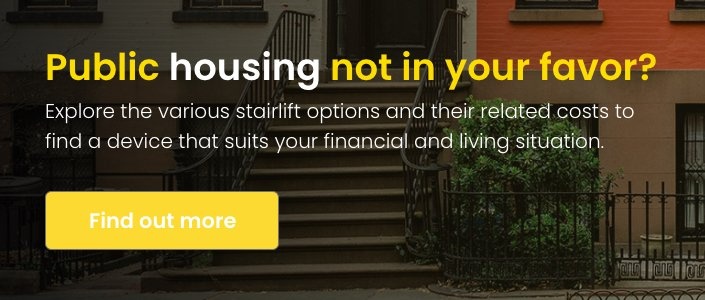Public housing does not allow stairlifts to be installed on-premises, which is both exclusionary and indifferent to the plight of people with disabilities. This is particularly problematic for those who are financially stretched by treatment and equipment costs, with public housing likely being the only viable, affordable option at the time.
- If the government cannot provide the help people so desperately need, where can they turn?
Know your rights and what alternative options are available to you
If you are recently or temporarily disabled and already living in public housing, the following information should be helpful.
Can an elevator be installed if there is not one on the premises already?
Under the Fair Housing Act, buildings developed for first occupancy after March 13, 1991 — as well as those with four or more units — follow accessibility rules that are defined by whether there is an elevator on the premises already. If there is an elevator, then every unit, public, and common space must be accessible to people with disabilities. This includes:
- Doors and hallways that can accommodate wheelchairs, including accessible routes within the units.
- Accessible light switches, thermostats, electrical outlets, and other environmental regulators.
- Kitchens and bathrooms must be wheelchair-friendly. For example, reinforced bathroom walls for grab bars.
For buildings without elevators installed, only ground-floor units and public/common spaces are required to be accessible for disabled people.
Can I request a first-floor unit if there is no elevator?
According to this LA Times article, a housing provider does not have to evict a first-floor tenant in favor of a person with a disability. Should there be no open first-floor units, the disabled tenant can request to be placed at the top of a waiting list should a first-floor unit become available. The tenant can also ask the landlord to ascertain whether any first-floor tenants are willing to change apartments voluntarily.
Related: In addition to legislative information, we offer practical tips to move around in a society built for those without disabilities in ‘Why Being in a Wheelchair Doesn't Confine You To the Ground Floor’.
What does Medicare offer and what alternatives are available?
With public housing installation not being worth a person’s trouble or time, people with disabilities and their loved ones must seek out other funding solutions or alternative methods of mobility.
This brings us to Medicare. Unfortunately, Original Medicare and its supplemental insurance policies do not offer any coverage for stairlifts. However, Medicare Advantage and its supplemental benefits may be able to offer financial assistance through a tailored plan that meets the specific needs of a recipient who requires a stairlift. To find out what options are available to you, visit the Medicare website.
Since both Medicare and public housing administrations offer little in the way of stairlift assistance, are there any alternatives that offer freedom and flexibility while circumventing the exclusionary rules of public housing?
The answer is yes.
Related: What medicare coverage can you expect for your stairlift?
Mobile stairlifts don’t play by public housing’s ‘no stairlift rules’
Mobile stairlifts don’t need rails or installation. In fact, all they require to deliver freedom of movement are the stairs themselves and a caregiver to maneuver the device up or down. Since installation costs are non-existent and structural changes are never needed, a person with a disability can use the mobile stairlift in public housing buildings without fear of violating unfair regulations.
For more information on the different types of stairlifts, their costs, and the staircases they can navigate, read our deep-dive ‘Stairlifts 101: Everything To Know Before You Purchase’.
Conclusion
With regards to public housing and stairlift installation, we believe that the current legislation is failing people when they need help the most. Freedom of movement and the ability to lead a comfortable, independent life should be guaranteed, whether you’re a person with a disability or not.
While public housing may not be an option, there are other avenues to explore with regards to financing a stairlift. For further advice and guidance, the team at Mobile Stairlift has compiled a comprehensive resource to aid you on your stairlift journey.
Read ‘How to Finance Your Stairlift In 2021’ here.


